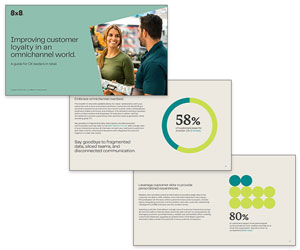Tricia Morris at 8×8 takes a look at the high cost of self-service channel switching and outlines three ways to address it.
More than ever, customers are engaging with organizations on digital channels for support, and when they do, self-service tools are a first stop for what customers hope will be a convenient and speedy resolution.
Increasingly, organizations are using conversational AI as the first point of contact for most self-service interactions.
But what happens when the chatbot can’t effectively help the customer? Customers expect an efficient transition over to a live agent that can help them without the customer having to repeat all of the information he or she provided to the chatbot.
The current need to switch from a chatbot to a live agent may be more common than you think. In a recent survey, Gartner found that 88% of all customer journeys that start in self-service channels end up touching multiple channels involving live agents.
So, what can organizations do to address channel switching from self-service, and what’s the cost of a frustrating transition?
The Cost of Self-Service Channel Switching
Switching between channels is a common occurrence for customers, and it can be easy or difficult. When it’s difficult, or high effort, it has significant impacts on customer satisfaction scores, brand loyalty, and reputation.
Unfortunately, according to the latest research from Gartner, almost two-thirds (62%) of customer service channel shifts are currently high effort.
High-effort channel transitions actively discourage customers from using self-service channels in the future.
The same Gartner research shows that less than half of the customers who have high-effort transitions from self-service to an agent will return to using self-service for their next support engagement.
This means organizations investing in chatbots and generative AI to improve customer satisfaction and reduce the use of higher-cost channels are effectively wasting that investment by creating bad transitions that drive customers away.
According to Eric Keller, Senior Director of Research at Gartner, companies have largely been approaching self-service switches with an undermining mindset.
“Many customer service and support leaders worry that creating easy transitions to assisted channels will undermine their self-service goals. Our research shows the opposite is true: 74% of customers who experience easy transitions to a customer service rep say they’ll return to self-service next time.”
This is a big deal. By not focusing on making it easy for the customer to transition to a live agent, organizations are pushing customers away from the self-service options that could benefit the overall customer experience and bottom line in big ways.
Three Ways to Improve Self-Service Channel Switching
So how can you make your self-service channel switches easy to improve CX and produce a better ROI on your self-service investments?
1. Context Improvements
Your organization needs solutions that let agents share customer context and conversation history. This is crucial to creating seamless channel switches because if information is lost during a switch, then customers have to repeat it.
And, as every contact centre agent or supervisor knows, customers hate repeating themselves. Having customer history gives agents a fuller picture of the context beyond the immediate conversation too, which can be beneficial when customers have experienced the same problem previously.
An additional benefit of improving context is saving agent time, which can positively impact your organization’s bottom line.
On average, easy channel switches save four minutes of agents’ time per interaction because information doesn’t have to be repeated. That quickly adds up to a lot of time saved across your organization.
2. Data Collection
Collecting customer information before being transferred to an agent can not just help in the moment, but it can also help solve an issue proactively.
If you highlight why you’re using self-service to your customers (i.e., to speed things up and make things easier for them) you’re more likely to succeed too.
By using tools you can customize your customer journeys with graphical click-and-add scripting. This enables you to collect customer data and create a script that highlights how your self-service channels are improving you customers’ experience and speeding their resolutions.
3. Journey and Friction Analysis
Collecting data on customer journeys is also key to improving self-service channel switches. By using contact centre analytics tools, you can see where customers are making channel switches and then make informed decisions to improve your processes and ensure easy transitions.
This blog post has been re-published by kind permission of 8x8 – View the Original Article
For more information about 8x8 - visit the 8x8 Website
Call Centre Helper is not responsible for the content of these guest blog posts. The opinions expressed in this article are those of the author, and do not necessarily reflect those of Call Centre Helper.
Author: 8x8
Published On: 16th Oct 2023 - Last modified: 9th Dec 2024
Read more about - Guest Blogs, 8x8






 8x8 is transforming the future of business communications as a leading Software-as-a-Service provider of voice, video, chat, contact centre, and enterprise-class API solutions, powered by one global cloud communications platform.
8x8 is transforming the future of business communications as a leading Software-as-a-Service provider of voice, video, chat, contact centre, and enterprise-class API solutions, powered by one global cloud communications platform. 
































